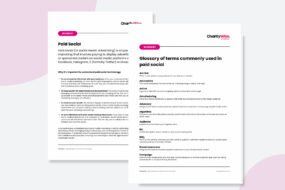

Social media has become an indispensable tool for charities to connect with supporters, raise awareness, and mobilise action. However, with numerous platforms available, it can be overwhelming to determine which ones are most suitable for your charity’s goals and resources.
In this guide we explore 5 steps that will help you navigate the social media landscape, identify the best platforms to engage with your audience, and develop a strategy that amplifies your cause while making the most of your available resources.
1. Know your audience
The first and most crucial step in developing a social media strategy is understanding who you are trying to reach. Knowing your audience’s characteristics will help you select the platforms that will have the most impact.
Key questions to consider:
- Age demographics: Are you trying to engage younger audiences who are active on TikTok, or a more established donor base on Facebook?
- Interests and online behaviour: Does your cause resonate with those who prefer the quick updates of X (Twitter) or those who appreciate visual storytelling on Instagram?
- Location: Are you a local charity with a focus on community outreach, or do you have a national or global mission? Different platforms may offer stronger engagement in specific regions.
Tip: Use audience research tools such as Google Analytics or social media insights (from platforms like Facebook, Instagram, and X) to understand your supporters’ online habits.
2. Research the platforms
Once you have a clearer picture of your audience, the next step is to evaluate the key features and user base of each platform to determine which one best suits your charity’s objectives.
- Facebook: With over 2.8 billion users, Facebook still has the broadest reach and is ideal for promoting events, fundraising, and connecting with a diverse audience
- Instagram: A platform for visual storytelling, Instagram is perfect for sharing high-impact images and videos of your work, success stories, and behind-the-scenes glimpses
- X (formally Twitter): Known for real-time updates and joining conversations through hashtags, X is ideal for advocacy, awareness campaigns, and rapid engagement with supporters and influencers
- LinkedIn: This professional network is great for connecting with potential corporate sponsors, volunteers, and high-level stakeholders, as well as showcasing thought leadership and organisational achievements
- TikTok: Popular with younger audiences, TikTok is the place for engaging, creative content with a lighter tone. It’s particularly effective for viral campaigns and community challenges
Additional platforms to consider:
- YouTube: If your charity produces longer videos, documentaries, or tutorials, YouTube is the go-to platform for in-depth visual content
- Pinterest: Useful for charities that focus on design, education, or lifestyle-based causes, Pinterest can help drive traffic through curated boards and how-to guides
3. Consider your resources
A successful social media strategy requires consistent effort and engagement, so it’s important to be realistic about your charity’s resources. Maintaining multiple social media accounts takes time, creativity, and a dedicated person or team.
Questions to ask:
- How many staff members or volunteers can contribute to managing social media?
- Do you have access to graphic design tools, video editing software, or photography equipment to create compelling content? You may want to read our guide on ‘Why your charity needs a free ‘Canva for non-profits’ account’.
- How often can you commit to posting and engaging with followers?
Start Small and Scale Up:
- It’s better to excel on one or two platforms than be mediocre across several
- Begin with the platform that best aligns with your audience and goals. As your expertise and resources grow, you can explore expanding your reach to other channels
4. Monitor and adapt
Your social media strategy should be dynamic and able to adapt to new trends, changes in audience behaviour, and emerging platforms.
- Monitor social media trends: Stay updated on which platforms are gaining traction and where your audience is shifting
- Analyse competitor activity: See which platforms similar charities are using and how they are engaging their audience
- Run pilot campaigns: Experiment with different platforms using a small budget to assess their effectiveness before full commitment
- Leverage social media listening tools: Track online conversations about your cause and relevant hashtags to identify where your audience is active
5. Engage and build relationships
Success on social media isn’t just about posting content—it’s about engaging with your audience and building a sense of community. Respond to comments, share user-generated content, and take the time to thank your supporters publicly.
- Engage with your followers: Like, comment, and respond to posts where your charity is mentioned to build a deeper connection
- Collaborate: Partner with influencers or other organisations in your space for cross-promotional opportunities
- Host Q&As or live sessions: Platforms like Instagram and Facebook offer live streaming, which can be a great way to answer supporters’ questions or share updates in real time
Remember, there is no one-size-fits-all approach to social media for charities. The best strategy is one that resonates with your audience and aligns with your organisational goals.
Other useful resources relating to social media:
Beginners guide to Paid Social.
Social Media Daily, Weekly, Monthly Checklist




